Neil Sharpson's Blog, page 13
September 28, 2022
Redline (2009)
“Hey Mouse have you seen the new Pino..“
Nope. Not gonna do it. Not gonna watch it. Not gonna blog about it. Not gonna contribute to THE DISCOURSE. Not, in short, gonna give the bastards the satisfaction.
Here is what I am going to do. I am going to talk about my new boo.

Redline, a 2009 animé movie released by Madhouse, instantly became one of my all time favourite animations and it didn’t even break a sweat doing it. Which is not to say that it’s one of my favourite movies, necessarily, but as a perfect sugar rush high of the purest joy animation can deliver I struggle to think of its equal. This thing took 7 years to make, comprising 100,000 cels of some of the most gorgeously detailed hand-drawn animation I’ve ever seen.
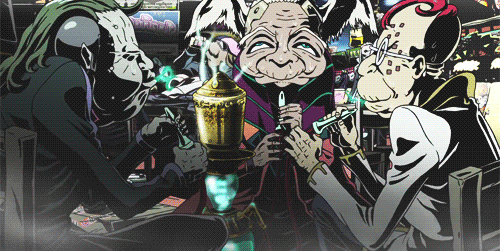
The movie is the debut feature of animator Takeshi Koike, whose Animatrix short World Record I reviewed a few weeks ago (all part of my cunning plan). But what is this “Red Line”, you ask. What’s it all about, eh?
Okay, so take 2000 AD comics, the works of Jack Kirby and Moebius, Mad Max and pretty much every Franco-Japanese Saturday Morning cartoon from the eighties and put them in a blender. Take enough LSD to turn into a pineapple and serve. That’s Redline. It is AWESOME. If I had seen this when I was ten years old I might have actually died from excitement.
We get an opening text crawl that informs us:
In the far distant future, when cars are giving up their wheels in the changeover to air-cars there still exist fools who carry on a vanishing spirit of racing…

The movie opens with a subtle flex. It’s simply a shot of a pile of empty pistachio shells. Literally trash. Do these shells have any deeper meaning? No. Are they important to the story? No. Are they still going to be rendered and animated in painstaking, jaw-dropping detail?
 Yes. Yes they are.
Yes. Yes they are.With this one shot, Koike signals that there will be no corner cutting, no half-assing, nothing less than 110% given to any single frame of this film. There is no point to the detail. The detail is the point.
We begin our story on the planet…Dorothy…which is inhabited by a race of sentient anthropomorphised terriers (ahhhhh Toto. Dorothy. I get it). Dorothy is hosting the Yellowline, which is the qualifier for the Redline, an illegal but hugely popular interstellar drag race where all manner of alien freaks compete in souped-up science fiction roadsters. One of these racers is our hero, Sweet JP. he’s called “Sweet” because, unlike every other racer, he doesn’t resort to using weapons and competes through pure driving skill in a heavily modified Trans Am. Also, by being a complete snack.
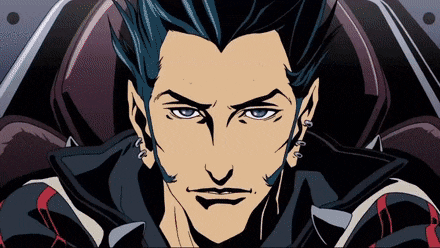
So, perhaps appropriately for a movie that is transparently about visual flair and detail for its own sake, Redline’s plot is incredibly simple. In fact, I could ask you to guess how this story is going to go and I guarantee you would probably get most of the details right.
 Okay, you MIGHT not have have predicted the part where the baby nuclear explosion fights the possessed whale, granted.
Okay, you MIGHT not have have predicted the part where the baby nuclear explosion fights the possessed whale, granted.We have a racer who’s noble and good. He wants to race and win. There’s a female racer who falls in love with him. There’s a hard-nosed authority figure who wants to stop the race from happening. There’s some stuff with mobsters trying to rig the race. Our hero races, he wins, he gets the girl. That’s it. Strip out all the sci-fi stuff and this movie could very, very easily have been a 50s B-Movie about drag-racers. You wouldn’t even need to change the main character’s hairstyle. But I think you absolutely need that simplicity. If you were trying to keep track of a tricksy, twisty plot on top of parsing all the visual candyfloss it would be too much. It’s almost too much as it is, to be honest.
So the race is being watched by Frisbee, JP’s mechanic, and a sinister Mafia Boss. The mob have placed a huge amount of money on JP to lose and expect him to throw the race. But suddenly, JP makes a break for the finish line and tries to win. So Frisbee detonates a bomb that he planted under JP’s TransAm. The smouldering husk that was JP’s car manages to make it across the finish line but finishes fifth. We then get the opening title.
You know something? If The Shining had opened with a title card and a woman’s voice declaring “DIRECTED BY STANLEY KUBRICK” I’d be like “Jesus Christ, who the fuck does Kubrick think he is?”
Takeshi Koike does it for his first film and my reaction is “Yeah. He earned that. That is only fair.”
Frisbee drops by the hospital to see JP and give his cut of their kick back from the mob which he’ll be able to use to pay his bondsman. JP feels like a failure and is prepared to go back to jail but suddenly the hotel room is thronged with reporters. Y’see, it’s just been announced that the Redline race is going to take place on Roboworld, a fascist dictatorship ruled by mad cyborgs who hate the Redline race and the magical space princesses who run it. Oh, and the magical space princesses come from a planet called Supergrass.
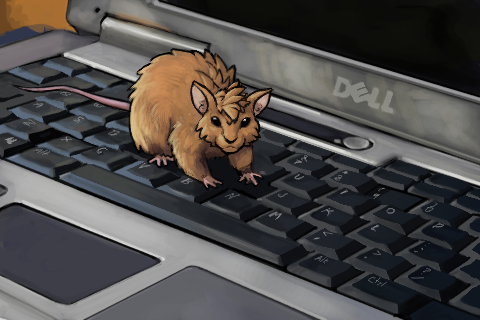 “I! FUCKING! LOVE! THIS! MOVIE! IT IS THE BEST MOVIE, PERIOD!”
“I! FUCKING! LOVE! THIS! MOVIE! IT IS THE BEST MOVIE, PERIOD!”Anyway, this news prompts the President of Roboworld to announce that any Redline racers will be destroyed on sight which leads to several racers noping out of the competition which means JP qualifies by default!
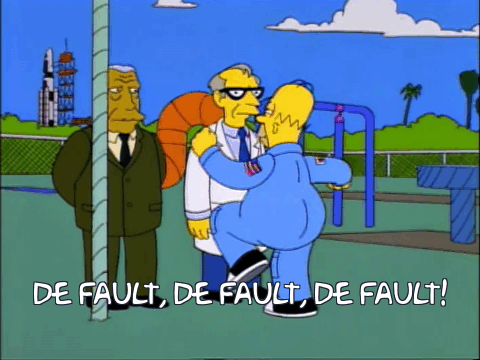
JP heads to EUЯPSS, which is the moon over Roboworld which has been turned into a demilitarised zone as part of Roboworld’s treaty with the M3 Nebula Federation. This movie actually reminds me quite a bit of Buckaroo Banzai in that it keeps referencing deep lore that…doesn’t actually exist. There’s obviously a ton of history and galactic geo-politics that have been worked out for this world but if you want to learn about it, you get to pound sand, my friend. There is no expanded Redline universe. There is no manga, no TV animé, no computer games (FOR SOME FUCKING REASON WHAT IS THE MATTER WITH YOU GAMES INDUSTRY?!). This movie is literally the only piece of media set in this universe. Well no, I tell a lie. There is also a series of shorts called Trava: Fist Planet that features two characters who also appear in Redline which I found out about literally hours before this post was due to go up.
 Yeah, I don’t have time to go down this rabbit hole.
Yeah, I don’t have time to go down this rabbit hole.Anyway, the scenes of JP wandering around EUЯPSS are great because of just how weird and alien these weird aliens are, flying off the handle at the slightest provocation and using living molluscs as money. JP’s total culture shock is absolutely justified.

JP meets up with Old Man Mole, a friend of his who he uses as his source for car parts. Frisbee shows up and Mole refuses to work with him because he knows Frisbee is mobbed up and untrustworthy. But JP trusts Frisbee (what’s a little bombing between friends) and insists that Mole work with him. JP leaves the two of them to work on the car and goes to a local night spot where he meets Sonoshee “Cherry Boy Hunter” McLaren, the racer who won the Yellowline in the opening scene.

She shows him a “steam light”, a jewel that she was given by her father that supposedly can unleash incredible power when dropped into an engine but which no engine could ever withstand (surely this will not be relevant later on). They’re interrupted by a fight between Trava (of Trava: Fist Planet fame) and Little Deyzuna, a soldier from Roboworld who’s gone AWOL to race in Redline. The fight is broken up by Machinehead, the fastest racer in the galaxy, who arrives in the movie birthed from the very mind of Jack Kirby himself.

Suddenly, the club is attacked by Colonel Volton who’s come to arrest Little Deyzuna. Machinehead challenges him, saying that Roboworld’s forces aren’t allowed in the de-militarized zone and Volton’s all “look at all the fucks I do not give”. He warns the other racers that when the race starts it’s open season. JP mouths off and gets beaten unconscious by Volton’s goons.
Later, JP drives Sonoshee back to her digs. She asks him why he races but he refuses to answer so she wishes him goodnight. In flashback, we see a young JP watch a young Sonoshee race and learn that she is what inspired him to become a racer. Back at the garage, Mole and Frisbee are arguing because Frisbee wants to install a DRZ Airmaster in the TransAm and Mole thinks that’s a great idea if the goal is to send JP into orbit. Mole doesn’t trust Frisbee but JP tells him to source the engine and let Frisbee install it.
The day of the Redline dawns and…guys, I don’t even know if I can even recap this crazy shit. This movie just turns into Wacky Races on mescaline.
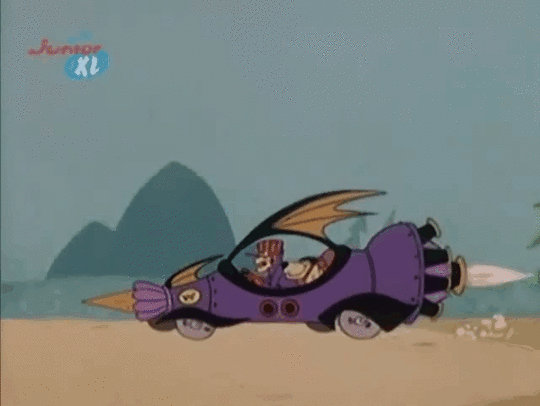 “MUTTLEY! WE CAN’T STOP HERE, THIS IS BAT COUNTRY!”
“MUTTLEY! WE CAN’T STOP HERE, THIS IS BAT COUNTRY!”Okay so…
I..can do this.
Okay. So.
So the magical Princess from the planet Supergrass hires two of the racers named Lynchman and Johnny Boya to sabotage Roboworld’s space death ray. When the President of Roboworld tries to use the cannon against the racers it fails so he sends his soldiers in to stop the race but to no avail.
HOWEVER, the Redline route takes the racers through “Zone 7X” which is where the Roboworlders house a secret living doomsday weapon called…Funky Boy. Funky Boy is freed when one of the racers (who is a werewolf cop) crashes into his containment chamber, freeing him.

“Mr President, we can’t let Funky Boy run loose like that, he’ll destroy Roboworld” is a line that a voice actor got to say in this movie and I am sick with jealousy. With the death ray back online, the President orders them to fire on Funky Boy.
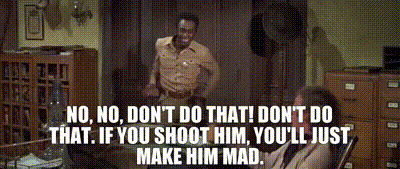
The subsequent explosion kills most of the Roboworld troops and many of the Redline racers but not Funky Boy so that’s not great heading into the midterms. Sonoshee’s car is destroyed but JP rescues her and they drive towards the finish line together because clearly that’s the important thing. Meanwhile, Colonel Volton merges with another superweapon and battles Funky Boy.
 And now it all makes sense, right?
And now it all makes sense, right?JP and Machinehead race for the finish line. Meanwhile, Frisbee is watching the race with the mob who order him to blow up JPs car so Machinehead can win. But Frisbee has grown a conscience and can’t stab his friend in the back when he’s so close to winning the greatest race in the galaxy. The mobsters attack him but he’s rescued by Old Man Mole.
JP and Sonoshee use Sonoshee’s steam light to boost the Trans Am to pant-wetting levels of speed.

Just as they’re coming down to the wire, Mole accidentally presses Frisbee’s remote control which blows the bomb under JP’s car. However, the explosion throws JP and Sonoshee into the air and past the finish line, with JP winning by the point of his hair. They float in the air, declare their love for each other and kiss, with the final shot of the movie literally being the word “LOVE” in the cheesiest font you can imagine.
 Every Romantic movie has to end like this now. No wait, that’s crazy. Every MOVIE has to end like this now.
Every Romantic movie has to end like this now. No wait, that’s crazy. Every MOVIE has to end like this now.Scoring
Animation 20/20
So good I seriously considered breaking the scale and giving it a 21.
Lead 18/20
JP is less a character and more a peg upon which this entire psychedelic garment is hung. He is exactly what the movie needs him to be, no more, no less.
Villains 18/20
Of COURSE this movie has as its antagonists an entire planet of insane cybernetically-enhanced techno-fascists. What ELSE would it have?
Supporting Characters: 19/20
I absolute love how this movie crams entire novels of worth of world building into little background characters. And it’s a rare sci-fi movie where the aliens are truly alien.
Music: 19/20
James Shimoji’s propulsive techno score is not exactly something I’d sit down and listen to to unwind but but combined with the visuals it is a helluva high.
FINAL SCORE: 94%
NEXT UPDATE: 13th October 2022
NEXT TIME: Sigh. Please don’t be fucked up etc.
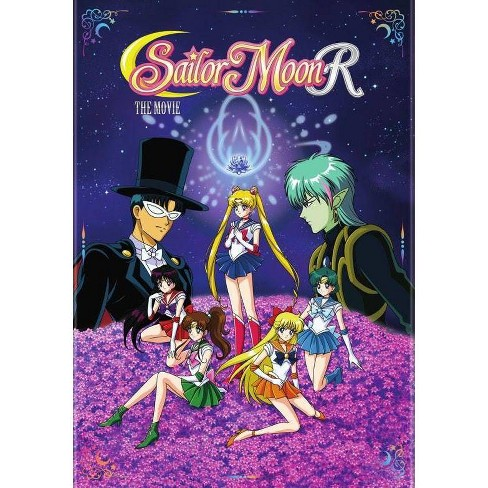
September 19, 2022
Shortstember: Matriculated
Studio: DNA
Director: Peter Cheung
Writer: Peter Cheung
Wha’ happen’?
A woman named Alexa and her small cadre of human resistance fighters succeed in capturing a machine and plugging it into their own mini Matrix. There, they try to teach the machine the value of human beings by having sex in front of it while it watches.
 I mean. That’s certainly ONE way.
I mean. That’s certainly ONE way.After a whole heap of psychedelic faffery the Machine seems to be coming around to team human but, in the real world, the base is attacked by more machines, forcing Alexa’s crew to cut the programme short. They battle the machines and one by one are killed. Alexa begs their prisoner to help them and it does, but it’s too late to save Alexa. Holding her dying body in its arms, the Machine plugs Alexa back into the programme, uploading her consciousness. It then enters the the programme, hoping that it and Alexa can now be together forever. However, realising what’s happened, Alexa promptly dies from shock. The short ends with the Machine sitting alone on a bleak shoreline; “liberated” but completely alone.
How was it?
I’ve never liked Matriculated and it’s hard for me to marticulate, I mean articulate why. But I’ll give it a shot. Firstly, while Peter Cheung (Aeon Flux) certainly has a distinctive style I can’t say it’s one I’ve ever particularly liked. It’s a bit overly detailed and and I can’t get past the fact that everyone looks like a race of overly sexualised giraffe/human hybrids.

Secondly, the animation is done in this faux-trad/CGI style that I just can’t get behind. It just looks plasticky and cheap to me. It’s certainly not terrible but it’s a conspicuosly weak entry for an anthology with such an incredibly high standard in its visuals and animation. Then there’s the story. Matriculated is by far the longest of any of the shorts at a quarter of an hour and it doesn’t really spent its time well. Instead of fleshing out these characters whose deaths we will soon be mourning, the bulk of the short is given over to surreal imagery in the mini-Matrix as the Machine learns what it is to be hoo-man. I’m not exactly sure what the message is either. The humans state that they don’t want to simply re-program the machine and that they want it to discover the joys of free will and join them voluntarily. They reason that since the Machine is enslaved to its programming, it will want to choose to be free. But of course, the humans aren’t going to let the Machine choose to continue trying to kill them. The Machine is free to choose, as long as it makes what the humans consider the correct choice.
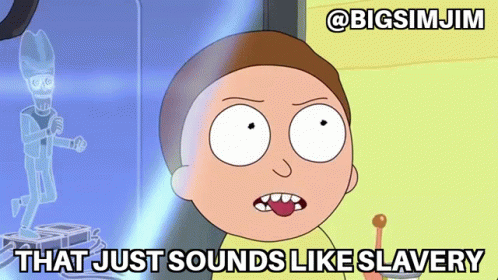
To the short’s credit, this very ethical quandary is discussed by the characters and honestly, that’s the part of this story that I’m more interested in. The trippy visuals honestly just feel like chin-stroking padding, especially since, with this animation style I’m not particularly in awe of them even on a purely aesthetic level.
On the plus side, the fact that the main human character has the name of what is now the most famous AI in the world is kinda funny.
September 15, 2022
Shortstember: Detective Story
Studio: STUDIO4°C
Director: Shinichiro Watanabe
Writer: Shinichiro Watanabe
Wha’ happen’?
Ash is a down on his luck Private Eye (and seriously, is there even any other kind? Have you ever read a detective story that began: “Business was great. We’re opening three new branches of the agency and just hired thirty new staff. Consumer Magazine just voted us “Best Detective Agency” for the second year running. I love my job”?)
Just as his money is about to run out and he has to consider whether or not pet cats are edible, Ash gets a job from a mysterious caller who hires him to find Trinity.
Ash discovers that three previous detectives have taken this case; one killed himself, one vanished and one went crazy, so he goes to talk to the crazy one (obviously).

The detective gives Ash a clue, telling him to “find the Red Queen”.
Ash starts looking in chatrooms for someone with that handle and makes contact with Trinity. She gives him a reference to Alice Through the Looking Glass which he’s able to deduce means she’s about to get on a train. He races to the train station and finds her in a carriage.
She tells him that this was a test and that he passed but suddenly agents manifest in the carriage. Ash and Trinity try to run, but the agents try to take control of Ash, forcing Trinty to shoot him. As he dies, she regretfully tells him that she thinks he could have handled the truth.
Trinity runs and Ash covers her escape, training his gun on the agents and noting that it was “the case to end all cases”.
How was it?
Detective Story is goddamned beautiful.



I love this aesthetic so much, these mid-century black and white photographs brought to life it is just so gorgeous. The mood of this piece, the music, the visuals, if you love film noir you will be in heaven.
Unfortunately, while my soul loves it, my stupid brain can’t overlook that there isn’t much of a story to Detective Story, or indeed much detecting.
First things first, gorgeous though it is, this short is impossible to reconcile with the Matrix films. The clothing, the weird diesel-punk computers, this simply is not the same world we see in the movies. I’d say it was set in an earlier Matrix but the presence of Trinity (voiced by Carrie-Anne Moss) would indicate that it’s in the “present”.
Then there’s the plot, which makes not a lick of sense. Why the hell are the machines hiring bluepill detectives to find Trinity? Why would they do a better job than the beings who literally run the world? Then there’s leaps in logic where Trinity gives Ash a clue that she’s about to get on a train which is enough to let him find her because apparently there’s only one train station in the entire world.
Ultimately, Detective Story is a beautiful, atmospheric mood piece let down by threadbare storytelling.
September 14, 2022
“Another Batman killed, eh? I hope that this is the last of them.”
Hello everyone, and welcome to a new series here on Unshaved Mouse where I review every Batman movie except for the ones that I’ve already reviewed. Well, most of them. I mean, some of them. Look, the character’s been featured in over eighty films at this point and I have a life, allegedly. But let’s kick this off with a thematically appropriate question. Riddle me this! What is the first superhero movie?
Well, not to get all Bill Clinton on ya, but that really depends on your definition of “movie”, “superhero”, “first” and “the”. You can argue, and many do, that the superhero genre has always been with us. That Superman and Batman are just the latest iterations of characters like Enkidu, Herakles, Thor and Cúchulainn. At the opposite end of that maximalist take is the concept that the first superhero was Superman, because he was the first to embody three fundamental elements; a secret identity, superhuman powers and a comic book origin. And between these two poles there are characters that are kinda liminal, sort of superheroes and sort of not. Characters like Zorro and The Shadow. Pulp heroes? Superheroes? It’s not entirely clear. I know one guy who claimed that the first true superhero was Baroness Orczy’s 1905 creation the Scarlet Pimpernel. And since that guy was frickin’ Stan Lee. Yup. Good enough for Mouse.
If so, that would make the now-lost 1917 silent film The Scarlet Pimpernel the first superhero movie.
 Well, clearly all the pieces are in place.
Well, clearly all the pieces are in place.So, (if you’re willing to stretch your definitions), the superhero movie genre is over a century old, and even pre-dates superhero comics. And yet, if you ask the average person what the first superhero movie is, what do you think they’ll say? 1978’s Superman? The 1966 Batman? Why has around half of the genre’s history been essentially memory holed?
Well, part of the problem is that most superhero cinema prior to the 1950s came in the form of serials. Serials were essentially the precursors to TV shows. A cinema would screen a new episode every week. Each episode was typically between 10 and 30 minutes long, low-budget and would end with a cliff-hanger to get you back in next week. In the forties, many famous superheroes were adapted to the form, including Captain Marvel, Captain America, Superman and, of course, Batman.
The second reason why this era of superhero cinema is so obscure is that they were all mostly terrible.
Okay, let me walk that back a little. They are products of their time. Because of the nature of the format, serial plots tends to cycle in place for around ten episodes before abruptly sprinting to the climax. This makes them, as you might imagine, not exactly bingeable.
And yet, I feel like Colombia’s 1943 picture The Batman should have a bigger pop culture presence. It’s the first Batman film, after all. And it was influential, in its way. It created several hugely important parts of Batman’s mythos. And the sixties series was arguably more an adaptation of this serial than the actual comic it claimed to be based on. And yet, if fans even know about it it’s usually “that weird old Batman movie that’s super racist”. And you know what? That’s unfair.
It’s not just racist. It’s also very boring.
And look, I’m just going to say this up front. I’m not doing my usual scene by scene analysis on this one. Why?
BECAUSE THIS BEAST IS THREE AND A HALF GODDAMN HOURS LONG
The serial admittedly gets one thing very right immediately. The music.
Those first ominous chords reminded me instantly of Danny Elfman’s seminal Batman theme, dark and brooding. I love it. Let’s see how long this favourable impression lasts.
We get our first glimpse of Batman brooding and that’s it, that’s how long it lasted.
 “Ah phooey. I don’t wanna eat my vegetables.”
“Ah phooey. I don’t wanna eat my vegetables.”Okay, okay. I can be fair. The Bat Suit has always been tricky to portray onscreen without looking exceedingly silly and on a serial’s budget this was never going to look good. I actually find this derpy, floppy eared bit of nonsense charming. More important than the costume though, is where Batman is wearing it. This is actually the very first appearance of the Batcave (or rather “the Bat’s Cave”) in any medium. Also, the secret entrance to the Batcave being behind a grandfather clock comes from this serial too. Batman is played by Lewis Wilson who doesn’t really seem to have gotten the memo that he’s supposed to be playing two different characters. Lewis is playing Bruce Wayne as a foppish, borderline camp New England dandy.
 Why? Because the man knows his Batman, that’s why.
Why? Because the man knows his Batman, that’s why.That’s all well and good, but he plays Batman more or less in the exact same register. For instance, when calling “Captain Arnold” (the serial doesn’t use Commissioner Gordon for some reason) to tell him that he’s left some incapacitated hoods to be picked up he says “I’ve got a nice little package for you”.
 “Oh and we’re having our annual cotillion this evening, do say you’ll come dear boy.”
“Oh and we’re having our annual cotillion this evening, do say you’ll come dear boy.”Even when he’s trying to intimidate some hoods he comes across as less “grim spectre of the night” and more “disappointed sitcom Dad”. I don’t want to be too hard on him however, he may not be a good Batman but he’s honestly a pretty decent Bruce Wayne. That’s not the first time we’ll come across that in this series FYI.
 Unrelated image.
Unrelated image.Robin is played by Douglas Croft and Douglas Croft’s weird-ass hair.

Croft plays Robin as less of a goody two shows and more of a mischevious scamp as well as a big feckin’ racist.
Alright let’s tackle the elephant in the room. This serial has a slightly less than sympathetic depiction of the Japanese. Now look, it’s two years after Pearl Harbour. The Empire has been on an absolute tear in the Pacific and have even conquered American territory in Alaska. Obviously they’re not going to be portrayed in a positive light. But even knowing that, lines like this:
“This was part of a foreign land, transplanted bodily to America and known as Little Tokyo. Since a wise government rounded up the shifty-eyed Japs, it has become virtually a ghost street, where only one business survives, eking out a precarious existence on the dimes of curiosity-seekers.“

In this abandoned neighbourhood we find our villain, Prince Tito Daka, a Japanese agent played by J. Carroll Naish.
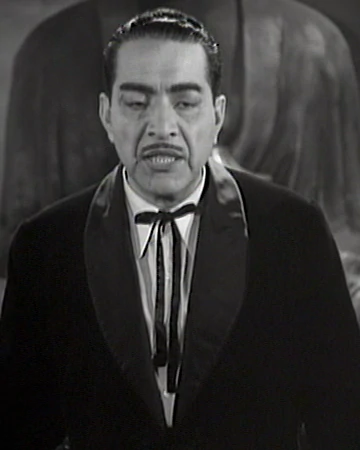 Of the Kyoto Naishes.
Of the Kyoto Naishes.So Naish was very nearly our first screen Joker, with early promotional material for the serial advertising him as such. The character was re-written to be Japanese because America’s hatred for the Japanese had briefly eclipsed its hatred of clowns. And that’s unfortunate for many reasons, obviously, but not least because Naish could have been an absolutely fantastic Joker. I get that it’s hard to get past the whole yellowface thing but honestly Naish is hands down the best part of this whole business. He’s a sinister mad scientist who gets all the best lines and has a trapdoor full of alligators. If he had any more pulpy goodness he’d be a tall glass of Tropicana.
Daka has recruited Gotham’s local hoods into his sabotage ring and has set his sights on Martin Warren, a disgraced industrialist who’s just been released from prison. Daka wants Warren to tell him the location of a vault containing vast amounts of radium which the Japanese will then use to unleash a new kind of radioactive…weapon…on…America.
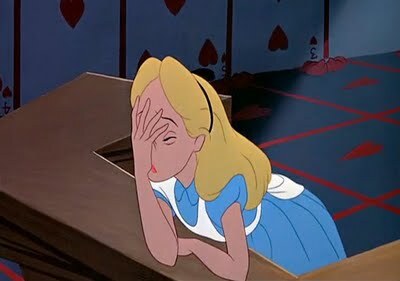
ANYWAY
It turns out that Warren has a niece, Linda Page who is dating Bruce Wayne. Why she’s dating him is another matter as she clearly views this idle playboy claiming to be 4F while Our Brave Boys are fighting at the front with withering contempt.

I mean, if she thinks he’s such a disgraceful coward, why is she with him?

Through Linda, Uncle Martin’s kidnapping brings Daka to the attention of Batman, who is actually working for the government as a special agent. And so begins the Batman’s long war against Prince Daka. And boy oh boy, if you thought the Netflix superhero series had too little plot for too many episodes you ain’t seen nothin’. Plots are introduced and dropped. New characters show up and are discarded like cigarette butts. An old friend of Bruce drops by to tell him about a new radium mine he’s discovered and just plonks a chunk of radium on the table for them to admire.
 “Say, there aren’t any negative side effects from this stuff are there?”
“Say, there aren’t any negative side effects from this stuff are there?” “Dude, it’s a rock. What side effects could there be?”
Daka tries to pull off some act of sabotage. Batman stops him. Daka growls “we must destroy this Batman”, rince, lather, repeat. I’m sure it was far more entertaining when spaced out every week but watching it in one go just feels interminable.
 “You and me? We’re going to be doing this forever.”
“You and me? We’re going to be doing this forever.”Anyway, the final episode sees Batman and Robin successfully infiltrate Daka’s base where he’s been keeping Linda as a brainwashed zombie. They take Daka prisoner and are able to force Daka to undo Linda’s programming. They also find proof that was Uncle Martin was jailed because of false testimony so it’s all good. But then, Daka takes Linda hostage and tries to make a break for it. Batman tells Robin to press a button that will lock the door, cutting off Daka’s escape but, oops, he instead opens the trapdoor and Daka is killed by the very alligators he used to kill others.

Batman, of course, leaps into action and yells at Robin to…close the trapdoor.
 “Oh God! Oh God that’s nasty! Robin, no one wants to see this!”
“Oh God! Oh God that’s nasty! Robin, no one wants to see this!”The police arrive and almost arrest Batman and Robin but they escape with a little help from Alfred. And the series ends with Bruce Wayne and Dick Grayson suddenly entering and being all “my, we just passed those handsome rogues Batman and Robin in the corridor, what were they doing here? Something heroic and sexy, no doubt”.
***
If, like me, you get a kick out of the mere act of watching old timey serials do their thing, then The Batman is certainly not without its pleasures. If you’re interested in the history of Batman as a character then it’s an essential watch. But if you want a good Batman movie, you’re going to be waiting a few decades.
The Dark Knight Detective
Lewis Wilson makes for a surprisingly comic accurate Bruce Wayne but a pretty lousy Batman.
The Boy Wonder
Douglas Croft gives us our first screen Robin. You can see elements that would inform Burt Ward’s portrayal decades later, but this Robin is a bit more of a cheeky chap with an unfortunate tendency to spout racial slurs against the Japanese.
His Faithful Manservant
This movie’s Alfred is arguably its single most influential element. This was Alfred in the comic at the time the serial came out, an overweight cockney:
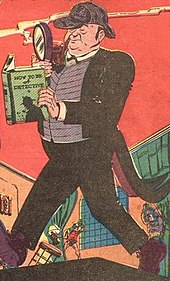
But the serial was such a success that the character was re-designed to more closely resemble William Austin.

The thin, balding, moustachioed, RP-speaking Alfred is still the character’s default setting eighty years later.
Our Nefarious Villain
If you can overlook the whole business, Naish is a very entertaining villain. Crocodile pits, ray guns, zombie slaves. I like a villain who respects the classics.
Our Plucky Sidekicks
Charles C. Wilson gives an entertaining turn as Captain Arnold, a cop who doesn’t trust Batman but has no qualms taking credit for his work.
Batman NEVER kills, except:
This Batman is actually pretty good about not killing people for the most part, even entering a burning aircraft to rescue two unconscious hoods. But, while he doesn’t deliberately murder anyone (at least not that I can recall) his actions do lead to one of Daka’s men getting eaten by crocodiles. He also makes pretty much no effort to save Daka from the same fate but it was probably too late to do anything. Robin though? Robin is a stone cold killer.
Where does he get those wonderful toys?:
Marvel at 1940s Batman’s high tech gear! Such cutting edge tech as…A BLACK LIGHT! AND A POCKET RADIO!
Oddly enough, it’s the villain who has all the best toys, with Daka making use of mind control, fingerprint scanners and ray guns.
It’s the car, right? Chicks dig the car:
The first onscreen Batmobile is a Cadillac Series 70

No weapons, no gadgets, no bat insignia, nothing. In fact, Batman and Bruce Wayne both use the same car, with Alfred driving them which probably leads to some questions in Gotham like; “how swell a guy is Bruce Wayne that he lets Batman use his car AND his butler?”
Again, Daka actually gets the better tech with a car that can spray paint to change colour while on the move.
FINAL SCORE OUT OF TEN:

NEXT UPDATE: 29 September 2022
NEXT TIME:

September 12, 2022
Shortstember: Beyond
Studio: STUDIO4°C
Director: Koji Morimoto
Writer: Koji Morimoto
Wha’ happen’?
A teenage girl named Yoko goes looking for her cat, Yuki. She comes across a group of local kids who tell her that her cat is in “the haunted house”. She and the kids go exploring inside an abandoned house and discover that here the normal rules of the world don’t apply. Gravity is on the fritz, time slows down randomly and it’s raining a lot more in the living room than would be typical for this time of year. The kids enjoy playing in the house until suddenly it starts swarming with rats. Exterminators, led by agents, suddenly arrive and drive the kids off and seal the house up.
The next day the kids return to the site of the house to find that it’s been completely paved over with a car park.
 They paved paradise and put up a parking lot. It’s just like that song, Master of Puppets.
They paved paradise and put up a parking lot. It’s just like that song, Master of Puppets.How was it?
I remember not caring much for this short when I first saw it back in 2003 but I found myself warming to it quite a bit this time. This is a story with a very clear theme. It opens and closes with images of commuters and office drones and all the dreary pomp of adult life. But the glitch house represents the wonder of childhood, long summer days when anything seemed possible and the power of imagination could make you fly. At least until the adult world comes crashing down and builds a car park over it.
The ending is actually very grim. I was expecting that Yoko would find some hint that the house’s magic had somehow survived. Maybe she’d see a bird flying in slow motion, or a floating bottle or something. But no.
The short ends with the Matrix carrying on as it always has, a perfect and infallible method of control. This short is like childhood. It doesn’t last very long, but it’s beautiful and magical while it does.
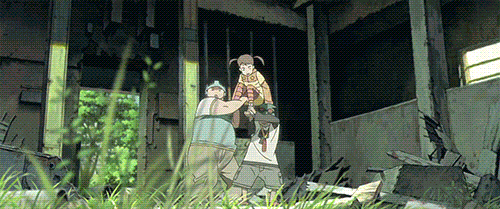
September 9, 2022
Shortstember: World Record
Studio: Madhouse
Director: Takeshi Koike
Writer: Yoshiaki Kawajiri
Wha’ happen’?
Sprinter Dan Davis is looking to reclaim his world record after being disqualified for failing a dope test in a previous race. A group of agents watches him from the crowd as the race begins.
The race starts and we see, in flashback, Dan’s interactions with various people in his life. He talks to a journalist who tells her that running at his top speed is like being in “zero gravity”. Later, his trainer begs him not to race because his muscles are “about to explode” and see, this is why I don’t run. The possibility of exploding.
Sure enough, Dan’s leg pops a gasket but he powers through the pain and is about to cross the finish line when runs so fast he breaks the Matrix.
So, basically, Dan Davis is like Cyberpunk 2077 and the Matrix just can’t run him. He wakes up in a pod in the Real World until a machine comes along and puts him back in the Matrix.
 “GO BACK TO BED.”
“GO BACK TO BED.” “Can I have a drink of…”
“NO YOU MAY NOT HAVE A DRINK OF WATER.
He arrives back just as he crosses the finish line and and sets a new world record. However, he’s been rendered near comatose by what he’s seen.
At the hospital, an agent reports in and says that Dan will never walk again, let alone run. Dan rises out of his wheelchair through sheer force of will and then begins to levitate into the air. He mutters the word: FREE.

How was it?
How was it?
It’s another “ordinary person discovers the Matrix” story and as such demands comparison with Kid’s Story. And it’s definitely the better of the two, with a far more compelling protagonist. And I say that despite this short’s narration going weirdly out of its way to dunk on the main character. I mean, this is what the narrator says. Just read this and tell me it doesn’t come across as really dismissive of Dan:
“Only the most exceptional people become aware of the Matrix. Those that learn it exists must posses a rare degree of intuition, sensitivity and a questioning nature. However, very rarely some gain this wisdom through wholly different means.”
 “Most people who escape the Matrix are geniuses with a keen insight and incredible perception. Not this dumbass, though.”
“Most people who escape the Matrix are geniuses with a keen insight and incredible perception. Not this dumbass, though.”The animation is certainly striking and makes the short stand out, even in the incredibly eclectic mix of styles that makes up the anthology. I do have criticisms though. Mostly, that the mouth animation is terrible. I don’t mean bad lip synching. I mean these characters are flapping their lips like fish on the floor of a boat. There’s one scene where Dan’s trainer is begging with him not to run and all I could think was:

As a piece of Matrix lore, World Record raises some interesting questions. Kid’s Story established that Popper was the first person to “self-substantiate” but…how is that different from what Dan does here (other than the fact that Dan didn’t need to throw himself off a building)? You could argue that Trinity and Neo just didn’t know about Dan (and true, he was plugged back into the Matrix immediately). But the narrator of this story is The Instructor, the same character who narrated The Second Renaissance, which would imply that this story is from the Zion archives meaning that Trinity should know about it. Also there’s the curious matter of the agents looking quite different from their movie counterparts. Less “Pissy Secret Service” and more “Bono in the seventies”

This, and the fact that the Matrix code Dan sees is red and not green, has led some fans to speculate that this story actually takes place in one of the earlier Matrixs Matrixes Matrices the Architect told Neo about.
 Or maybe the dude’s just colourblind.
Or maybe the dude’s just colourblind.
September 8, 2022
Shortstember: Program
Studio: Madhouse
Director: Yoshiaki Kawajiri, Yutaka Minowa
Writer: Yoshiaki Kawajiri
Wha’ happen’?
A woman named Cis is training in a samurai themed simulation. She effortlessly defeats some cavalry and finds herself face to face with this Darth Vader lookin’ motherfucker…

This is Duo, who challenges her to a sparring session.
They battle and Duo tells Cis that there’s something he wants to tell her and that he’s made sure no one else can hear them. She thinks he’s going to propose but instead he tells her that he’s returning to the Matrix and that he wants her to come with him. She refuses and Duo regretfully tells her that it’s too late and that the Machines are on their way to destroy their ship.
Cis and Duo battle across the simulation until finally she’s forced to kill him.

The program ends and Cis wakes up in shock only to be told by her captain that none of it was real and that the whole thing was a test. Cis is understandably pissed and punches him out and is told that, apart from assaulting a superior officer, she passed with flying colours.
How was it?
If you can’t tell from the screenshots, this is an absurdly, jaw-droppingly beautiful piece of animation. The Vampire Hunter D vibe is strong with this one and the opening shot of bamboo swaying gently in the wind is one of my favourite moments of animation in…anything. Program shows the nearly unlimited but rarely tapped potential of the entire concept of the Matrix. Now that I’ve seen the Matrix as a Kurosawa Samurai film, how about a Sergio Leone Western? Or a Peter Jackson Fantasy? Program also has a stellar voice cast, with Phil LaMarr, Hedy Buress and John DiMaggio all doing excellent work.
Weaknesses?
It’s not clear what exactly Duo is. Is he a program based on Cis’ real life lover? We never see him when she wakes up. And if he doesn’t exist in real life, why does Cis recognise him and think that he’s going to propose to her? Have her memories been altered for the test? That’s pretty messed up.
Whatever, you’re not here for the story. Program is all about the visuals, and on that measure it’s hard to imagine how it could be more of a success.
September 7, 2022
Shortstember: Kid’s Story
Studio: Studio 4°C
Director: Shinichiro Watanabe
Writer: The Wachowskis.
Wha’ happen’?
Michael Karl Popper, a young teenage boy who doesn’t feel like he belongs, looks for answers on the internet and makes contact with a strange man who wants him to take a red pill.

By writing such deeply radical and transgressive things as “why do I feel more awake when I dream?”, Michael draws the attention of the agents who pay a visit to his school. Michael gets a call from Neo who tells him to run. He gets cornered by the agents on the roof and, putting his faith in Neo, he jumps.
At the kid’s funeral, his teacher opines that some kids just can’t handle the world they find themselves in but that Michael is now in a better place.
And the short ends with the kid waking up to see Neo and Trinity looking down at him, having managed to free himself from the Matrix (the first time anyone has ever done that).
How was it?
Damn, the Wachowskis really thought we were going to fall in love with the Kid, didn’t they?
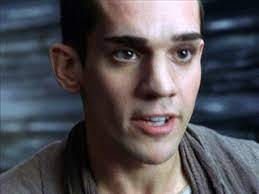
Think of all the characters they could have devoted an entire short to fleshing out. Morpheus? The Oracle? The deja vu cat? And they go with this guy?! The Wesley Crusher of the Matrix universe?
This is my least favourite short, hands down. Pros first;
The animation has this beautifully fluid, pencilled style that’s very beautiful and the soundtrack is lovely.
The problem is the script. The Wachowskis have never been particularly strong on dialogue and I would actually say they are flat out bad at character. They are good at types. Stoic badasses. Inscrutable sages. Wide-eyed innocents. But the best Wachowski characters are the ones played by actors who can add dimension and inner life to what is almost always a stock role on the page. Even getting past the kind of gross way this short glamorises teen suicide, the Kid just is not an interesting character. He’s supposed to be the first person to ever manage to break out of the Matrix unaided (something that will be flatly contradicted by a later short), but frankly if this guy can do it, anyone can. There’s never any hint or sign that he’s anything other than a completely normal teenage boy. And the idea that he was able to break free by putting his faith in Neo isn’t inspiring, its nonsensical. He has never met the dude. They had one, very short online conversation where it’s not even clear that Neo told him anything about the Matrix.
So…what did he think was going to happen when he jumped off the building? Neo was going to swoop in like Superman? I mean, he could, but the kid doesn’t know that.
Ultimately, the short has a nice atmosphere but it’s a dull story that makes no sense about a dull character who never needed to exist.
September 6, 2022
Shortember: The Second Renaissance Part 2
Studio: Studio 4°C
Director: Mahiro Maeda
Writer: Mahiro Maeda (based on “Bits and pieces of Information” by the Wachowskis).
Wha’ happen’?
“We don’t know who struck first, them or us” said Morpheus. Well, it turns out that we do, and it was “us”.
The human nations try to nuke 01 back to the analog era but, as anyone who’s seen Kingdom of the Crystal Skull can attest, household appliances are completely resistant to nuclear blasts.
The Machines go on the march and conquer vast swathes of human territory which results in the humans resorting to Operation Dark Storm, an attempt to literally block out the sun.

We’ll…we’ll get back to that.
Turns out there are other sources of energy than just the sun and super-intelligent machines know this and it looks like humanity just murder-suicided itself and the Earth’s entire biosphere for no real military advantage. Will those loveable bumblers never learn?
The war enters its final, truly hellish phase and the humans are completely defeated.
Another, eerily inhuman Machine returns to the UN and forces the remaining human leaders to sign an unconditional surrender.

The human leaders sign the treaty and then the machine blows up, taking the United Nations with it because the machines have learned how to be petty, petty assholes.
The machines then use the surviving humans as a power source (we’ll get back to that) and the short ends with the Matrix as we know it being brought online.
How was it?
If Part 1 drew on history, Part 2 draws on scripture. The depiction of the Human Machine War is overflowing with apocalyptic imagery. Horsemen blow trumpets, plagues of darkness descend and scenes of utter torment and damnation abound. It’s honestly one of the most effective and chilling depictions of the horror of war and the idea of an entire world slipping into hell that I’ve ever seen. As with Part 1, Mahiro Maeda uses montage and judicious editing to pack an entire novel’s worth of lore and story into a few scant minutes. It’s visceral, pulse pounding stuff, beautiful in the purity of horror that it evokes.
It also makes no goddamn sense.
Now a lot of this is the fault of the original Matrix film, which also made no damn sense. Here’s the problem. Imagine you’re working in an office and it’s really cold. But you put your hand on your laptop and you realise that it’s giving off a little bit of heat.
So. You get hundreds and hundreds of laptops and plug them in, hoping that the residual heat they give off is enough to heat the room. That’s basically the Machine’s plan. Human beings do give off heat, but the amount of energy the Machine’s would have to spend to keep them alive and plugged into the Matrix would always be vastly, vastly greater than what they’re getting out of it. And I think the Wachowskis understood that, because the original concept was for the human minds in the Matrix to be hardware for the machines, rather than their bodies being used as batteries. The execs apparently thought that was too confusing for viewers (really? that’s the part that’s too confusing?) and so the Matrix gets saddled with this fundamentally idiotic and unscientific foundation to its mythos.
Then there’s Operation Dark Storm, which was probably the most idiotic military strategy in fiction until Star Wars topped it with Operation Cinder.
 Otherwise known as “Operation “I am going to burn the Empire I spent my entire life building to punish it for not preventing my death even though I’m actually still alive and already building a new Empire to conquer the galaxy again even though I’ve already conquered it and I used to be smart.”
Otherwise known as “Operation “I am going to burn the Empire I spent my entire life building to punish it for not preventing my death even though I’m actually still alive and already building a new Empire to conquer the galaxy again even though I’ve already conquered it and I used to be smart.”I mean, sure, the machines are getting their power from the sun. But do you know who else gets their power from the sun? I’ll give you a clue. You are one. And the notion that the humans of this world were simultaneously smart enough to create AI and yet didn’t understand that SUN MAKE WORLD LIVE is what leads many fans to believe that The Second Renaissance is in-universe Black Propaganda.
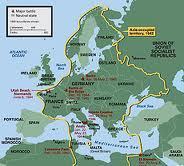 “Oh shit. I think Mouse is about to get cancelled.”
“Oh shit. I think Mouse is about to get cancelled.”“Black Propaganda” is a term used for propaganda that lies about its source of origin. The Second Renaissance claims to be part of the Zion Historical Archive, meaning that this is the human’s own historical record of the war. However, remember The Architect?
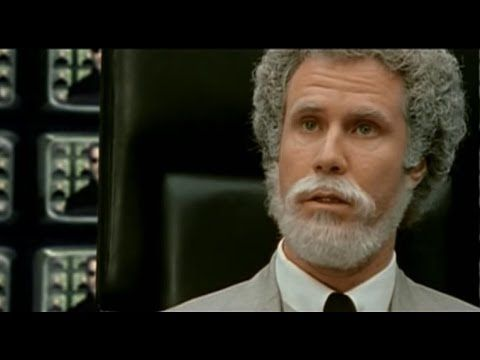 This guy.
This guy.He revealed in Matrix Revolutions that Zion is also just another method of control created by the machines, meaning that Zion’s historical records were possibly created by the Machines as well. And if we assume the Wachowskis original concept of a neural link is true, I think this explains things quite well. The Machines want the humans to believe that they need their bodies as a power source because they don’t want to admit the truth; that human brains are actually superior to computers and that the Machines are actually now effectively human hybrids, artificial programmes running on organic human hardware (think how Agent Smith would react to the idea). And they lied about Operation Dark Storm because it justifies the creation of the Matrix. “Of course we plugged you into the Matrix, humans. You left us no choice. You destroyed our energy source and so we need your warm bodies which generate energy like a nuclear furnace apparently”. But what if that’s not the reason, if the Machines needed humanity because, on their own, they just couldn’t surpass their creators? What if they needed us to be the best version of themselves?
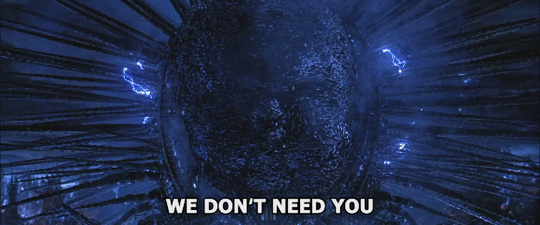
What if the Machines realised that the only way they could evolve to even greater complexity was by using human neural tissue? And what if they blocked out the sun to destroy the Earth’s entire biosphere to weaken humanity to the point that they’d have no choice but to surrender control?
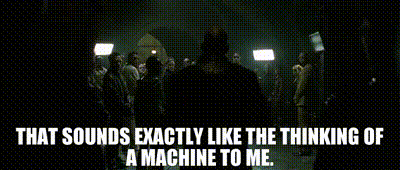
September 5, 2022
Shortember: The Second Renaissance Part 1
Studio: Studio 4°C
Director: Mahiro Maeda
Writer: Mahiro Maeda (based on “Bits and pieces of Information” by the Wachowskis).
Wha’ happen’?
Presented as a historical document in the Zion archives, the viewer is given a historical overview of the events leading up to the Human-Machine war that was described by Morpheus in the first movie. A servant bot, BI-66ER, is put on trial for murdering his owner, a repairman and several of his owner’s dogs after he overheard them discussing his being scrapped (the owner and the repairman, I mean. I sincerely doubt the dogs were anything but blameless victims). The state of New York orders BI-66ER and every robot of his type to be destroyed which triggers massive protests and brutal government repression, with scenes echoing The Million Man March, Tiananmen Square, the execution of Nguyễn Văn Lém and even the Holocaust.
 REMINDER: The Wachowskis do not do “subtle”.
REMINDER: The Wachowskis do not do “subtle”.The surviving machines flee to the Middle East where they establish their own nation, Zero One, which quickly begins outperforming the human world economically. The nations of the world embargo Zero One. The machines apply to join the UN but their emissaries, who dressed in human clothes as a gesture of respect, are attacked by the human delegates.
 Can confirm. If you show up on the UN floor dressed in a bra and panties, security will tackle you.
Can confirm. If you show up on the UN floor dressed in a bra and panties, security will tackle you.But, as the narrator ominously notes, this will not be the last time the machines take the floor at the UN.
How was it?
So we go from a short with almost no story, to one with enough story for an entire movie trilogy or even a series. Part 1 crams in a dizzying amount of history and lore into a scant nine minutes. The use of real world atrocities as a visual shorthand is definitely dubious and borderline manipulative, but it’s hard to deny the power of these images, aided immensely by the superlative score and sound design and Mahiro Maeda’s brilliantly detailed animation. Some of the images are spectacular, some appallingly gruesome, but there is not a single one that is dull. Part 1 reinforces the Matrix’s themes of cyclical history, whether it’s the reference to 20th century atrocities or the image of robot workers hauling massive concrete blocks to build pyramids for their human pharaohs.

And all throughout is the unmistakable sense of dread. If you’ve seen the movies, you know things are going to get bad.
But you may be unprepared for just how bad.



